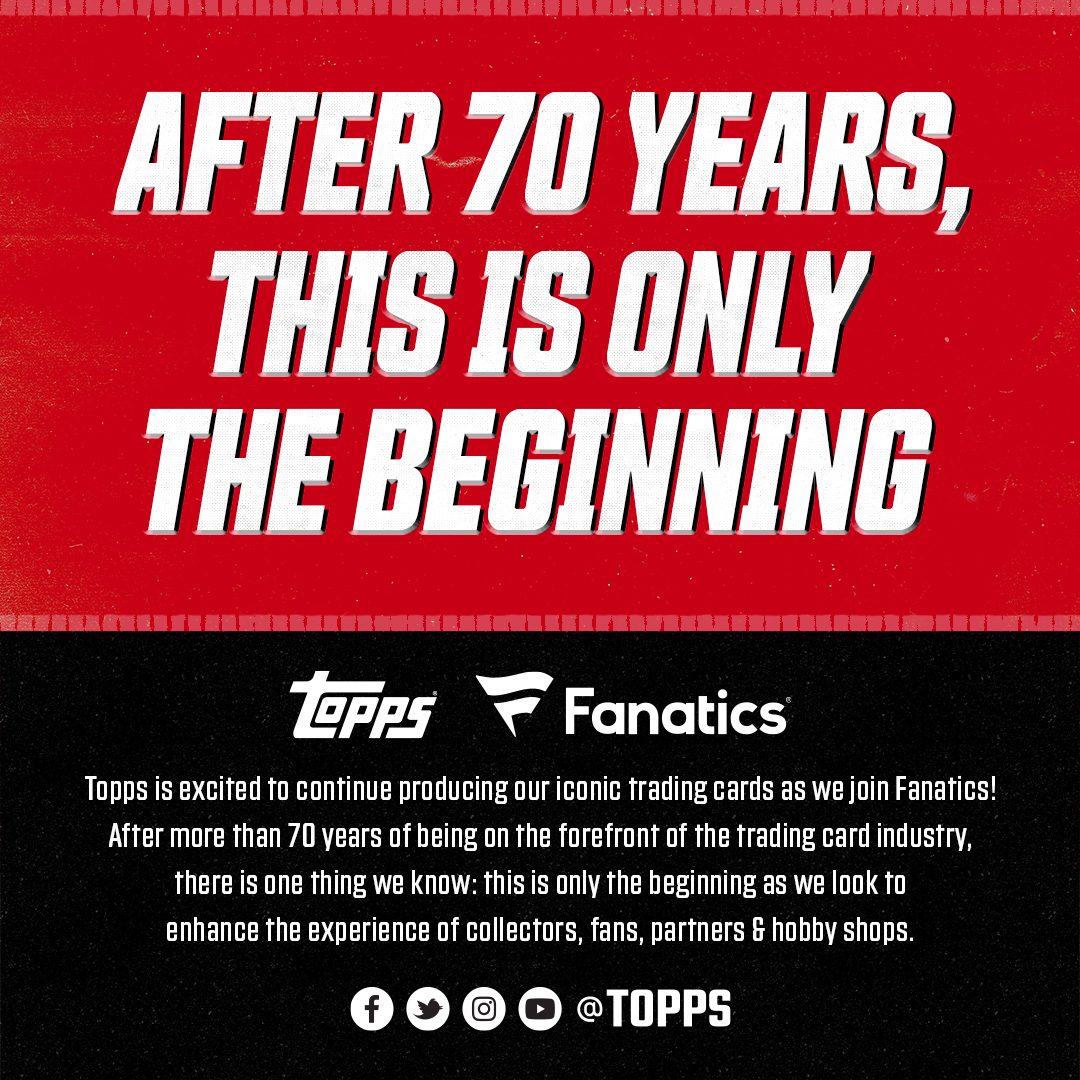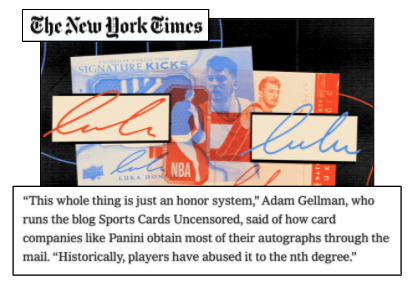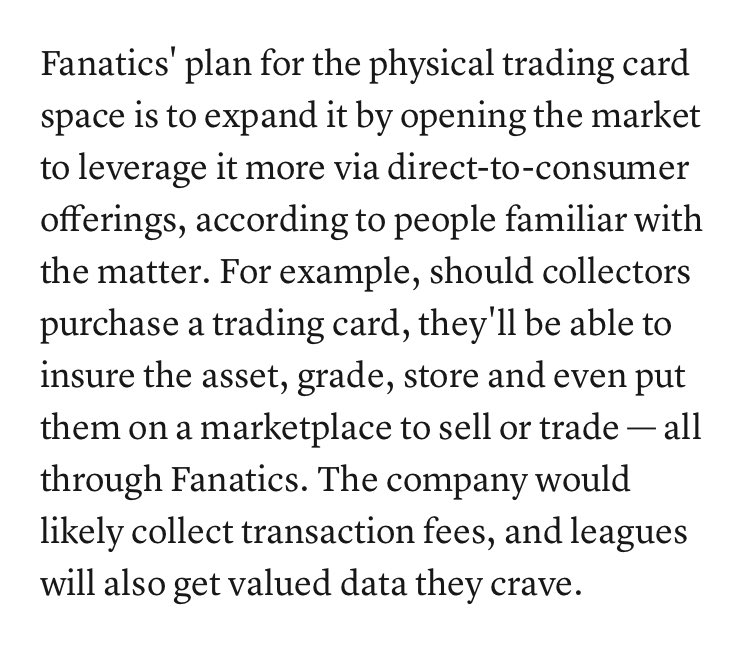Ive done quite a bit of writing over the last few months pertaining to the enormous shift that is going to happen in this industry over the next few years. Fanatics is taking the world by storm, and with a recent CNBC and WSJ article outlining some of what sources are telling them is going to happen, we are in for an adventure.
Here is a quick blurb from the CNBC article that highlights some of the consolidation that Fanatics is looking to undertake:
In addition, the article in the WSJ outlined new series funding that Fanatics has secured to bankroll their new division, as well as add to the war chest of resources and support they were already in possession of, or planning to acquire. If I had to guess, the next five years will be the time used to build a foundation across the industry that will turn its current existence up side down.
If you are unfamiliar with the landscape, here is how I break it down.
- Production – Actually producing the cards. Building sets, art, content. Packing out the goods.
- Distribution – getting the product into the hands of other parties, either wholesalers, shops or collectors
- Retail – the actual sale of the cards at a point of service, either online, in person, or through a partner
- Marketplace – Resale of singles, wax, or products
- Grading – self explanatory
- Breaking – The community of group breakers
- Storage – I wouldnt normally add this, but COMC has shown how big of a business this can be
That means there are give or take 8 sections of the industry, all with established businesses to service that portion that will need to be consolidated. This doesnt mean that Fanatics is going to wipe these businesses off the face of the earth, but if there is exclusivity in building infrastructure around their main competitive advantages, its going to be hard to operate as a third party adjacent business.
Production
Believe it or not, this is likely the main challenge that Fanatics is going to face, especially considering the size and scale of what they are taking over. Panini, Topps and UD put out HUNDREDS of products each year, and it should be expected that Fanatics isnt going to walk back their participation, especially if the licenses come with a minimum guarantee the way that previous ones did.
That means that they will need to source, complete and produce a lot of sets from scratch, or purchase intellectual property to help facilitate that. To produce a set you need ideas, art, memorabilia, signatures, and the actual card making materials. Im thinking that Fanatics maybe has some ideas, but im not sure how much scale they have in the other areas.
Because production is as much about the people as anything, I would expect a hiring spree over the next year or so to bolster their division. Digital artists to create the designs based on the ideas from the product/brand managers. If they were ambitious, they could try to build unique products for all three sports, but I doubt that is going to happen at first.
When Upper Deck lost pretty much everything back in the 2009 / 2010 timeframe, Panini and Topps went and scooped up a lot of their best talent. Most of whom are still with the companies today. To think that wont happen again with Fanatics is naïve, but they might want to go a different direction.
Lets say they decide its best to just pick up a company as a whole, as its easier to start with a whole car instead of trying to buy all the parts individually and build your own hot rod. Upper Deck and Topps seem to be the most likely targets as they have more attractive IP for the cost it would take to acquire it. Sure they can go after Panini America, but their umbrella organization seems to be more intent in keeping that division open. Topps and UD seem to be more built around their brands, with Bowman, Exquisite and SP Authentic being some of the most valuable product IP in the industry. Upper Deck also has exclusives with LeBron James and Michael Jordan, both of whom havent had autographed cards in an NBA uniform during the past 10 years. Upper Deck is a much smaller operation, and likely ten times cheaper to acquire, thus making me lean that direction. The exclusive player licenses alone could be a game changer if they are transferrable with the sale of the company.
Outside of actually making the sets, they need to get the cards built, which I have no idea about, so Ill have to skip over that. Those resources are finite, and if I am Panini, Im working on exclusives with as many of those people as possible to lock out the team coming in.
Then it moves onto signatures and memorabilia. Given that Fanatics will have unprecedented access to the leagues, the memorabilia for current athletes will likely be a non issue. Especially now that Panini has made it wholly acceptable to use non-game worn materials in the cards. Panini literally tore down the one barrier to entry out of necessity and now Fanatics can walk right through that door.
Autograph deals are something Fanatics already has in place, and the PA licenses will make it very easy to get more. This might be the one area they can do better than any other company out there, especially if they have access to new players that were tied up in exclusives before.
Distribution
Lets start with the way things are set up now. You have a manufacturer who is building the products, distributors like GTS, Peach State and Southern Hobby that buy the products from the manufacturers and resell them at a higher cost to shops, and then retailers who sell those boxes to consumers. Over the last 10 years, the direct to consumer lane has opened up, as has group breaking, but ill get there in a second.
Right now, Fanatics is a global retailer with huge presence across the three leagues. They have stores, they have distribution and they have a gigantic online storefront that does huge business across hundreds of licenses. If they are going to use that infrastructure, to move trading card product, look out.
There are also big box retail outlets involved like Target and Wal Mart, which have been ravaged by idiots looking to make money on the hobby explosion over the course of the pandemic. Fanatics can service that as well.
Here is the challenge that has defined the way cards are made for decades – the manufacturers dont want to be in the business of holding product. They want to make it and ship it, they do not want to pay for warehouse space to hold it long term. They also didnt want to be in league with hundreds of tiny shops around the nation who didnt know how to run a business. Things like credit, pre-orders and shit like that were a bridge too far, especially entering into an age where everything is done online. We have all seen what that shift has meant for shops refusing to enter the 21st century.
Naturally, entities were created to exploit that. Take that off the plates of the manufacturers who were already struggling to make ends meet. Distributors have ran things around the hobby for a long time – that is until Group Breakers came on the scene. But again, we will get to that.
Because Distributors controlled where the product was going in a large portion of the run of any set, they had a ton of power to dictate how the future product runs were delivered. Sometimes it was for a good reason dictated directly to them by demand from the collecting base they serviced, other times it was solely for their own good. Sure, Panini and Topps sold directly to shops in some cases, but not enough to remove the distributors from the equation.
Unlike Topps, Panini and UD, Fanatics has a web already constructed in some of these areas, and if they were smart, they wouldnt let places like Blowout or their compatriots take any of that competitive advantage away. For a hobby like this, influence is everything, and I would be exceptionally hesitant about adding more seats at the table when you dont have to.
The last 2 years aside – this hobby has been on a downturn in most of the main areas populated by everyday consumers. Over the last two years, some of that power has gone back into the hands of the manufacturers because demand has been insatiable. Unfortunately, that also meant that many shops relied on old methods that were unable to scale and unable to support a growing tidal wave of interest from the population.
The advent of group breaking also helped to grow things in an exponential way, but even then, their presence still relied heavily on distributors to be a middle man in the supply line. Older product is something that currently has no place at the manufacturers, and that’s where most of the purchase power shifts directly into the hands of everyone’s least favorite power brokers.
If I am Fanatics, I would do everything in my power to break this cycle with consolidation in the most pressing possible way. Because Fanatics is as much a global distributor as they are a retailer, the need to push product around the old way doesnt need to exist. Additionally, because they have retail stores and relationships to market directly through the leagues themselves, Im not sure if they need the card shop market structure anymore.
Card shops will argue that they are the ambassadors, but with things the way they are, Fanatics may not want it that way. It all depends on the end goal that the new world order is designed to accomplish. If its mass market appeal, catering to shops around the country who dont have standardized presentations shouldnt be the plan. That’s where a fanatics retail experience will be the most important aspect of this new model.
Retail
Everyone knows exactly what to expect when they walk into an Apple Store. Everyone knows exactly what they are buying when they buy a McDonald’s Cheeseburger. That consistency does not exist in the hobby today across any aspect of the supply chain. Everyone who is reading this blog has been in a card shop. Everyone who is reading this blog has likely had a negative experience too.
With Trading Cards as investment pieces the new normal, its time for the shops to grow up as much as the products. There is a reason that the market exists the way that it does in the pandemic era, and most of it has to do with how unprepared the hobby was for the giant droves of attention that have come to our front door.
This also begs the question of whether or not Fanatics sees value in continuing down the current retail path or if they are looking to expand their reach. Will trading cards eventually be the investment pieces that they are right now, or will that also be coupled with access that isnt available right now. Will other spending levels be considered as viable segments because the audience is likely going to be larger? I believe they are heavily weighing a future where the only people that can join the hobby are those with tons of disposable income.
Remember, access to affordable products is what most collectors are harping on right now, because things have shifted so dramatically towards super premium methods of spending. I have always said that driving towards the higher end of things was the best option, only because the audience was so small. If the audience is bigger, the revenue generated per head can be a lot smaller.
That’s where these retail experiences can cater to both sides of the same coin. Either offer retail store that offers product along side all the licensed gear that already populates their stores, or create a premium shopping experience like buying a Rolex or a Tesla. There are no need for dingy shops in strip malls to be your ambassadors if you can build these cards into your existing retail empire.
Marketplace
The horror stories of the secondary market are so frightening that the fear of a negative buying experience has become as important as a flawless deal. So many times, eBay has been the primary marketplace, alongside Facebook, where billions of dollars change hands collector to collector, and little accountability on either side of the deal leads to gigantic universal issues.
In the articles we have already been clued into the fact that Fanatics wants to be a provider in this space as much as they are a supplier. Consolidating the marketplace has worked incredibly well in some hobbies, but it would change the game in this hobby. Being able to buy single cards or secondary market wax in a trustworthy environment would be so welcome that it could expand reach of this hobby all by itself.
Because the negative experiences are so widespread, its curious to think how a new collector to collector marketplace could exist under a new direction. I have always said escrow like transactions are the best approach, where collectors each send to a hub, who can validate each side of a deal before it is then sent to the other party. This can also work in a COMC like marketplace where the assets are all stored like a bank to be bought and sold through a third party.
Its easy to see here where Fanatics can step in, deliver the collector to collector experience we have all been clamoring for as well as a manufacturer direct to consumer approach that has become popular with Panini and Topps over the last 10 years.
Panini has offered single card purchases directly to the consumer for a few years now, but the scale was always limited by their relationships elsewhere that could be damaged by the change in market direction. Fanatics shouldnt have any of those dependencies, thus opening up a new stream of revenue that can deliver cards in a new way.
Grading
If you want to know my feelings on the grift that is the grading business, go search at the top of the page. I do not support grading as a service or as a business. There are too many conflicts of interest. To think that Fanatics could enter into this part of the hobby isnt shocking, but it could be interesting to see how it goes down.
This is one area where they have no footing, and really dont have a way to enter the market the same way they do in some of the other areas Im discussing in the article. Of all the numbers on my list, this is the one that I think they have the largest disadvantage.
Group Breaking
I once heard that before the boom, group breaking accounted for about 60% of all product sales across the hobby. I would argue that during the first upturn, it was probably more than that. Now, because individuals are more likely to want to avoid groups in their wax ripping investments due to the secondary market value of the tent pole hits in a product, I would think that number has dropped dramatically in percentage, but increased in volume.
The funniest thing is, all the manufacturers could have brought group breaks in house and prevented their products from being delivered to consumers in this fashion. There still isnt a legal precedent that says its kosher to offer a product this way. Fanatics could be the first manufacturer to limit distribution to the usual suspects, and prevent the conflict of interest that exists with manufacturers and breakers working together.
Without direct sales to group breakers, and creating their own versions of a marketplace for break slots, Fanatics could revolutionize this sometimes shady aspect of the hobby over time. I think the scale of it might be too large to undertake along side the other items on their startup list, but its cool to think about how this could go down. If access is the true goal, that’s where this could all be done, above board, and with oversight to deliver a positive customer experience.
Storage
The last aspect of the chain I want to discuss is one that was made popular by services like COMC. Places where collectors can house their wares and not have to worry about the sales aspect in a way like they do collector to collector. Because of the amount of space this requires, and what we have read in the articles, I think this area of the hobby is one Fanatics will target as well. Being able to store, sell and ship cards directly will undoubtedly be part of their plan, because they do it already.
Fanatics has sold single cards for almost a decade, and I would expect them to explore card storage areas very quickly because of the ease to break into the market when you control all the aspects of the supply chain.
Even though most of this article is speculative at this point, it should go without saying that change is coming. Massive change. If you own a hobby adjacent business or rely on this hobby for enjoyment, the next few years is going to be a wild ride. Fanatics set themselves up with one thing that is rarely plentiful in this hobby – time. They have four years to get this in motion, and I would argue that might be as much of a bad thing as it is a good thing. There are so many elements here that need to be hashed out, and its going to be interesting to see where their priorities lie. Best of luck to everyone, we are going to need it.






